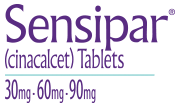References: 1. Sensipar® (cinacalcet) prescribing information, Amgen. 2. Data on file, Amgen; [Cinacalcet Integrated Analyses of Efficacy; 2003]. 3. Goodman WG. Calcium and phosphorus metabolism in patients who have chronic kidney disease. Med Clin North Am. 2005;89:631-647. 4. Hruska KA, Mathew S, Lund R, Qiu P, Pratt R. Hyperphosphatemia of chronic kidney disease. Kidney Int. 2008;74:148-157. 5. Wesseling-Perry K, Harkins GC, Wang HJ, et al. The calcemic response to continuous parathyroid hormone (PTH)(1-34) infusion in end-stage kidney disease varies according to bone turnover: a potential role for PTH(7-84). J Clin Endocrinol Metab. 2010;95:2772-2780. 6. Komaba H, Shiizaki K, Fukagawa M. Pharmacotherapy and interventional treatments for secondary hyperparathyroidism: current therapy and future challenges. Expert Opin Biol Ther. 2010;10:1729-1742. 7. Goodman WG, Quarles LD. Vitamin D, calcimimetics, and phosphate-binders. In: Brenner BM, Levine SA, eds. Brenner & Rector’s The Kidney. 8th ed. Philadelphia, PA: Saunders Elsevier; 2008:1904-1927. 8. Teng M, Wolf M, Lowrie E, Ofsthun N, Lazarus JM, Thadhani R. Survival of patients undergoing hemodialysis with paricalcitol or calcitriol therapy. N Engl J Med. 2003;349:446-456. 9. Data on file, Amgen; [ESRD Dialysis Patient Chart Audit; Q2 2014]. 10. Kidney Disease: Improving Global Outcomes (KDIGO) CKD-MBD Update Work Group. KDIGO 2017 Clinical Practice Guideline Update for the Diagnosis, Evaluation, Prevention, and Treatment of Chronic Kidney Disease–Mineral and Bone Disorder (CKD-MBD). Kidney Int Suppl. 2017;7:1–59. 11. Messa P, Macário F, Yaqoob M, et al. The OPTIMA study: assessing a new cinacalcet (Sensipar/Mimpara) treatment algorithm for secondary hyperparathyroidism. Clin J Am Soc Nephrol. 2008;3:36-45. 12. Ureña-Torres P, Bridges I, Christiano C, et al. Efficacy of cinacalcet with low-dose vitamin D in incident haemodialysis subjects with secondary hyperparathyroidism. Nephrol Dial Transplant. 2013;28:1241-1254. 13. Data on file, Amgen; [Clinical Study Report 20070360–Incident Dialysis Study; June 27, 2012]. 14. Data on file, Amgen; [Pooled Phase 3 PTH and Calcium Reductions by Baseline Calcium Analysis; November 2012]. 15. Brunelli SM, Dluzniewski P, Cooper K, Do T, Sibbel S, Bradbury BD. Serum calcium reductions among patients on hemodialysis initiating cinacalcet. Poster presented at: The American Society of Nephrology Renal Week; November 11-16, 2014; Philadelphia, PA. 16. Food and Drug Administration Center for Drug Evaluation and Research. Clinical review for NDA 21-688. Available at: http://www.accessdata.fda.gov/ drugsatfda_docs/nda/2004/21-688_Sensipar.cfm. Accessed June 21, 2015. 17. Data on file, Amgen; [Pooled Phase 3 Concurrent Achievement of PTH and Serum Phosphorus Targets During the Efficacy Assessment Phase; November 2014]. 18. Data on file, Amgen; [Cinacalcet New to Brand Patient Persistency; 2008-2014]. 19. Centers for Medicare & Medicaid Services (CMS). Implementation of the transitional drug add-on payment adjustment. Transmittal R1889OTN. https://www.cms.gov/Regulations-and-Guidance/ Guidance/ Transmittals/2017Downloads/R1889OTN.pdf. Accessed August 17, 2017.

